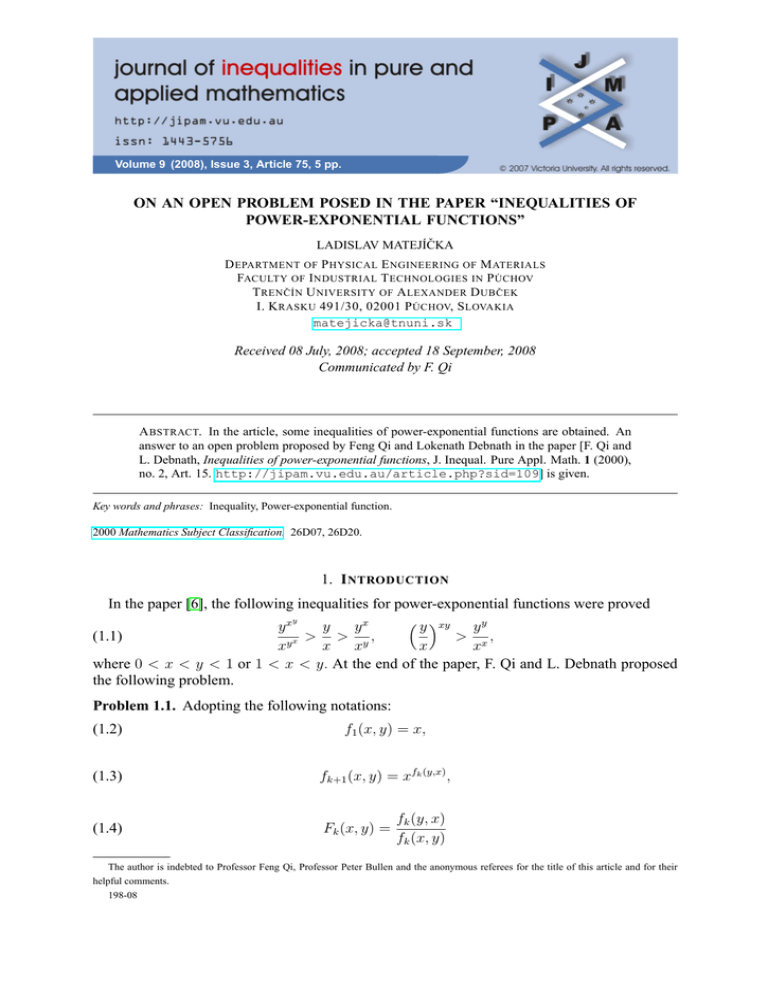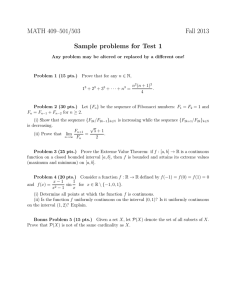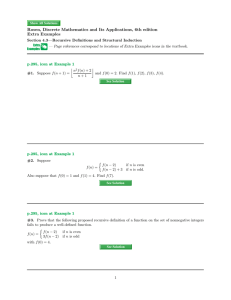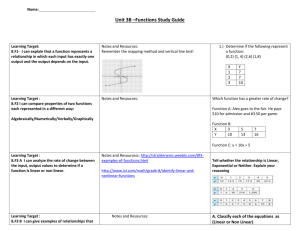ON AN OPEN PROBLEM POSED IN THE PAPER “INEQUALITIES OF CKA
advertisement

Volume 9 (2008), Issue 3, Article 75, 5 pp. ON AN OPEN PROBLEM POSED IN THE PAPER “INEQUALITIES OF POWER-EXPONENTIAL FUNCTIONS” LADISLAV MATEJÍČKA D EPARTMENT OF P HYSICAL E NGINEERING OF M ATERIALS FACULTY OF I NDUSTRIAL T ECHNOLOGIES IN P ÚCHOV T REN ČÍN U NIVERSITY OF A LEXANDER D UB ČEK I. K RASKU 491/30, 02001 P ÚCHOV, S LOVAKIA matejicka@tnuni.sk Received 08 July, 2008; accepted 18 September, 2008 Communicated by F. Qi A BSTRACT. In the article, some inequalities of power-exponential functions are obtained. An answer to an open problem proposed by Feng Qi and Lokenath Debnath in the paper [F. Qi and L. Debnath, Inequalities of power-exponential functions, J. Inequal. Pure Appl. Math. 1 (2000), no. 2, Art. 15. http://jipam.vu.edu.au/article.php?sid=109] is given. Key words and phrases: Inequality, Power-exponential function. 2000 Mathematics Subject Classification. 26D07, 26D20. 1. I NTRODUCTION In the paper [6], the following inequalities for power-exponential functions were proved y y xy yx y yx yy (1.1) > > , > , xy x x xy x xx where 0 < x < y < 1 or 1 < x < y. At the end of the paper, F. Qi and L. Debnath proposed the following problem. Problem 1.1. Adopting the following notations: (1.2) f1 (x, y) = x, (1.3) fk+1 (x, y) = xfk (y,x) , (1.4) Fk (x, y) = fk (y, x) fk (x, y) The author is indebted to Professor Feng Qi, Professor Peter Bullen and the anonymous referees for the title of this article and for their helpful comments. 198-08 2 L ADISLAV M ATEJÍ ČKA for 0 < x < y < 1 or 1 < x < y, and k ≥ 1, prove or disprove the following inequalities: (1.5) F2k−1 (x, y) > F2k (x, y), (1.6) F2k+4 (x, y) > F2k+1 (x, y). That is, (1.7) F2 (x, y) < F1 (x, y) < F4 (x, y) < F3 (x, y) < F6 (x, y) < · · · . There is a rich literature on inequalities for power-exponential functions, see [1, 2, 3, 4, 5, 6]. It is well-known that, if 0 < x < y < e, then xy < y x . (1.8) If e < x < y, then the inequality (1.8) is reversed. If 0 < x < e, then (e + x)e−x > (e − x)e+x . (1.9) For details about these inequalities, please refer to [1, p. 82] and [4, p. 365]. In what follows we will continue to use the notations (1.2), (1.3) and (1.4). 2. M AIN R ESULTS Theorem 2.1. Let e < x < y. Then the following inequalities hold: (2.1) f2n (y, x) < f2n (x, y) < f2n+1 (x, y) < f2n+1 (y, x) < f2n+2 (y, x). Remark 1. The inequalities (2.1) can be rewritten as follows x y y x < xy < xy < y x < y x yx < xy xy < xy x xy < yx y yx < ··· . Proof. We prove (2.1) by mathematical induction. It is evident that fn (x, y) < fn+1 (x, y), fn (y, x) < fn+1 (y, x). The inequality f2 (y, x) = y x < xy = f2 (x, y), is known and it implies x y xy < y x which is f3 (x, y) < f3 (y, x). Suppose that (2.1) holds for n ≤ k. To prove (2.1) for n = k + 1, it is sufficient to show that f2k+2 (y, x) < f2k+2 (x, y). In fact, if f2k+2 (y, x) < f2k+2 (x, y), then f2k+3 (x, y) = xf2k+2 (y,x) < y f2k+2 (x,y) = f2k+3 (y, x). The inequality f2k+2 (y, x) < f2k+2 (x, y) is equivalent to (2.2) f2k (x, y) ln y − f2k (y, x) ln x > ln ln y − ln ln x. We prove (2.3) f2k (x, y) ln y − f2k (y, x) ln x > ln y − ln x, which gives (2.2), because ln y − ln x > ln ln y − ln ln x. The inequality (2.3) can be rewritten as (f2k (x, y) − 1) ln y > (f2k (y, x) − 1) ln x or as R f2k−1 (x,y) t y dt ln y ln y > R 0f (y,x) , 2k−1 ln x xt dt ln x 0 which is equivalent to Z f2k−1 (y,x) t Z x dt − (2.4) 0 J. Inequal. Pure and Appl. Math., 9(3) (2008), Art. 75, 5 pp. f2k−1 (x,y) y t dt > 0. 0 http://jipam.vu.edu.au/ O N AN O PEN P ROBLEM 3 Denote by Z f2k−1 (y,x) t Z f2k−1 (x,y) y t dt. x dt − H(x, y) = 0 0 The direct computation yields ∂H(x, y) ∂f2k−1 (y, x) ∂f2k−1 (x, y) = f2k (x, y) − f2k (y, x) − ∂y ∂y ∂y Z f2k−1 (x,y) ty t−1 dt. 0 Using mathematical induction, we obtain ∂f2k−1 (y, x) = f2k−1 (y, x)f2k−2 (x, y) · · · f2 (x, y) lnk−1 x lnk−1 y ∂y k−1 X 1 + f2k−1 (y, x)f2k−2 (x, y) · · · f2k−2j (x, y) lnj−1 x lnj−1 y, y j=1 (2.5) ∂f2k−1 (x, y) x = f2k−1 (x, y)f2k−2 (y, x) · · · f2 (y, x) lnk−1 x lnk−2 y ∂y y k−2 X 1 + f2k−1 (x, y)f2k−2 (y, x) · · · f2k−2j−1 (x, y) lnj x lnj−1 y, y j=1 (2.6) for k > 1. for k > 1. Using (2.5) and (2.6) we get ∂H(x, y) = f2k (x, y) · · · f2 (x, y) lnk−1 x lnk−1 y ∂y k−1 X 1 + f2k (x, y) · · · f2k−2j (x, y) lnj−1 x lnj−1 y y j=1 x − f2k (y, x) · · · f2 (y, x) lnk−1 x lnk−2 y y Z f2k−1 (x,y) k−2 X 1 j j−1 − f2k (y, x) · · · f2k−2j−1 (x, y) ln x ln y − ty t−1 dt y 0 j=1 = h1 (x, y) + h2 (x, y) + h3 (x, y), where h1 (x, y) = x f2k (x, y) · · · f2 (x, y) ln y − f2k (y, x) · · · f2 (y, x) y lnk−1 x lnk−2 y, k−2 1X (f2k (x, y) · · · f2k−2j−2 (x, y) ln y − f2k (y, x) · · · f2k−2j−1 (x, y)) lnj x lnj−1 y, h2 (x, y) = y j=1 1 h3 (x, y) = f2k (x, y)f2k−1 (y, x)f2k−2 (x, y) − y J. Inequal. Pure and Appl. Math., 9(3) (2008), Art. 75, 5 pp. Z f2k−1 (x,y) ty t−1 dt. 0 http://jipam.vu.edu.au/ 4 L ADISLAV M ATEJÍ ČKA Since (2.1) holds for n = 1, . . . , k and ln y − h2 (x, y) > 0. Next, we get h3 (x, y) = f2k (x, y)f2k−1 (y, x)f2k−2 (x, y) x y > 0, ln y > 1, we obtain that h1 (x, y) > 0, 1 y − f2k (y, x)f2k−1 (x, y) following the same arguments. So we have H(x, x) = 0. The proof is complete. ∂H(x,y) ∂y 1 1 1 + f2k (y, x) − >0 2 y ln y y ln y y ln2 y > 0. This implies that (2.4) holds because Theorem 2.2. Let e < x < y. The inequalities F2n+2 (x, y) < F2n−1 (x, y) hold. Proof. Put f0 (x, y) = f0 (y, x) = 1 and f−1 (x, y) = f−1 (y, x) = 0. The inequality F2n+2 (x, y) < F2n−1 (x, y) is equivalent to f2n+2 (y, x)f2n−1 (x, y) < f2n−1 (y, x)f2n+2 (x, y), which can be rewritten as f2n−2 (x, y) ln y + f2n+1 (y, x) ln x > f2n+1 (x, y) ln y + f2n−2 (y, x) ln x. Rewriting the above inequality we have ln y f2n+1 (y, x) − f2n−2 (y, x) > , f2n+1 (x, y) − f2n−2 (x, y) ln x which is equivalent to Z f2n (x,y) t Z f2n (y,x) xt dt > 0. y dt − (2.7) f2n−3 (x,y) f2n−3 (y,x) The inequality (2.7) holds because x < y, f2n−1 (x, y) < f2n−1 (y, x), f2n (y, x) < f2n (x, y). Theorem 2.3. Let e < x < y. The following inequalities hold: (2.8) F2n (x, y) < F2n−1 (x, y). The proof of Theorem 2.3 is similar to the proof of Theorem 2.2 therefore, we omit it. The answer to the open problem proposed by Feng Qi and Lokenath Debnath [6] is: for e < x < y the inequalities F2k−1 (x, y) > F2k (x, y), k = 1, 2, ... hold and the inequalities F2k+4 (x, y) > F2k+1 (x, y), k = 0, 1, ... are reversed. R EFERENCES [1] P.S. BULLEN, A Dictionary of Inequalities, Pitman Monographs and Surveys in Pure and Applied Mathematics 97, Addison Wesley Longman Limited, 1998. [2] LIU-QING HAN, BAI-NI GUO AND FENG QI, New proofs for inequalities of power-exponential functions, Mathematics and Informatics Quarterly 11(3) (2001), 130–132, RGMIA Research Report Collection, 4(1) (2001), Article 2, 9–13. [ONLINE: http://www.staff.vu.edu.au/ rgmia/v4n1.asp]. [3] G.H. HARDY, J.E. LITTLEWOOD sity Press, Cambridge, 1952. AND J. Inequal. Pure and Appl. Math., 9(3) (2008), Art. 75, 5 pp. G. PÓLYA, Inequalities, 2nd edition, Cambridge Univer- http://jipam.vu.edu.au/ O N AN O PEN P ROBLEM 5 [4] J.-C. KUANG, Applied Inequalities (Changyong Budengshi), 2nd edition, Hunan Education Press, Changsha, China, (Chinese), 1993. [5] FENG QI, A method of constructing inequalities about ex, Univ. Beograd. Publ. Elektrotehn. Fak. Ser. Mat.,8 (1997), 16–23. [6] FENG QI AND L. DEBNATH, Inequalities of power-exponential functions, J. Inequal. Pure and Appl. Math., 1(2) (2000), Art. 15. [ONLINE: http://jipam.vu.edu.au/article.php? sid=109]. J. Inequal. Pure and Appl. Math., 9(3) (2008), Art. 75, 5 pp. http://jipam.vu.edu.au/





